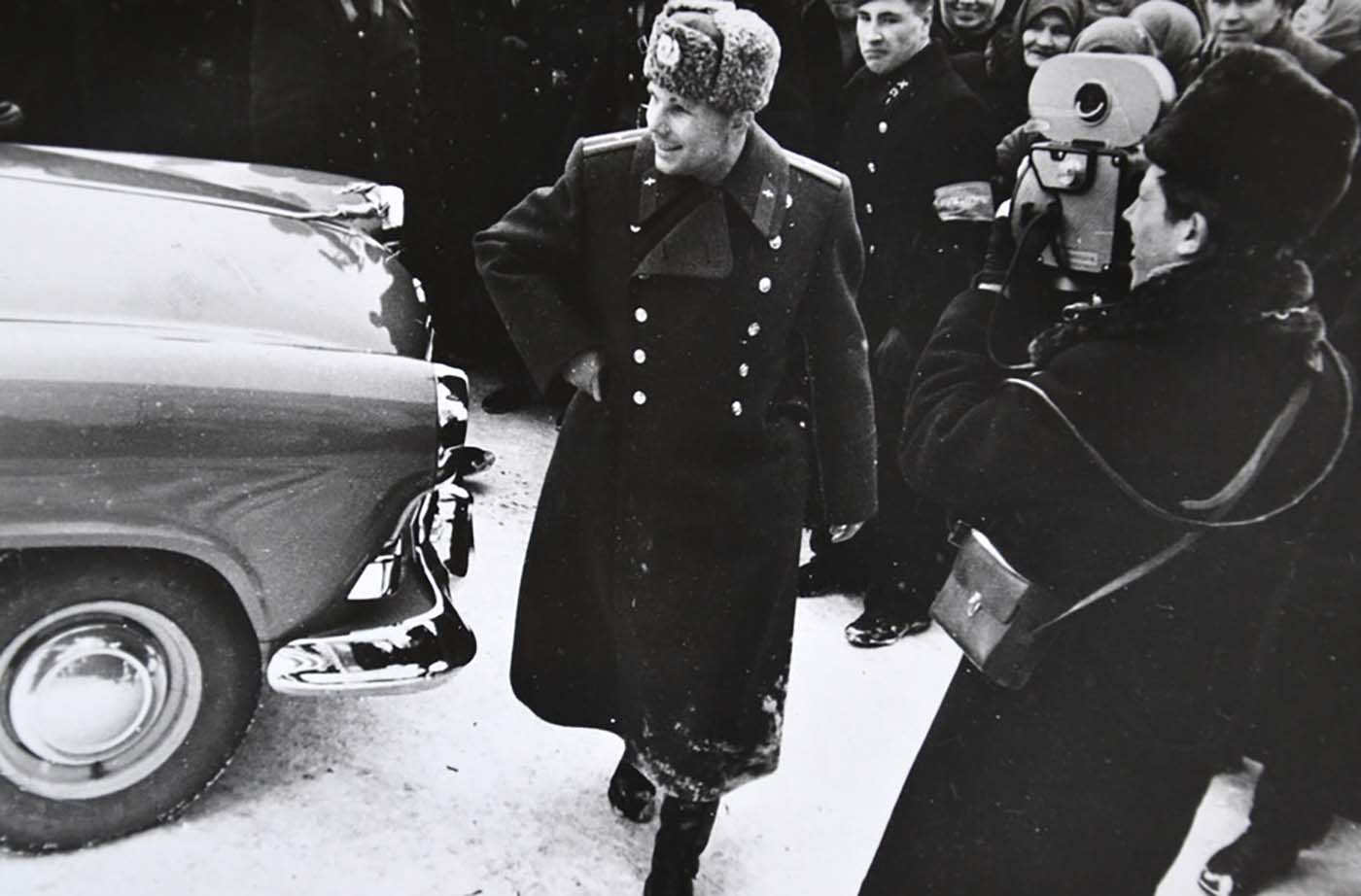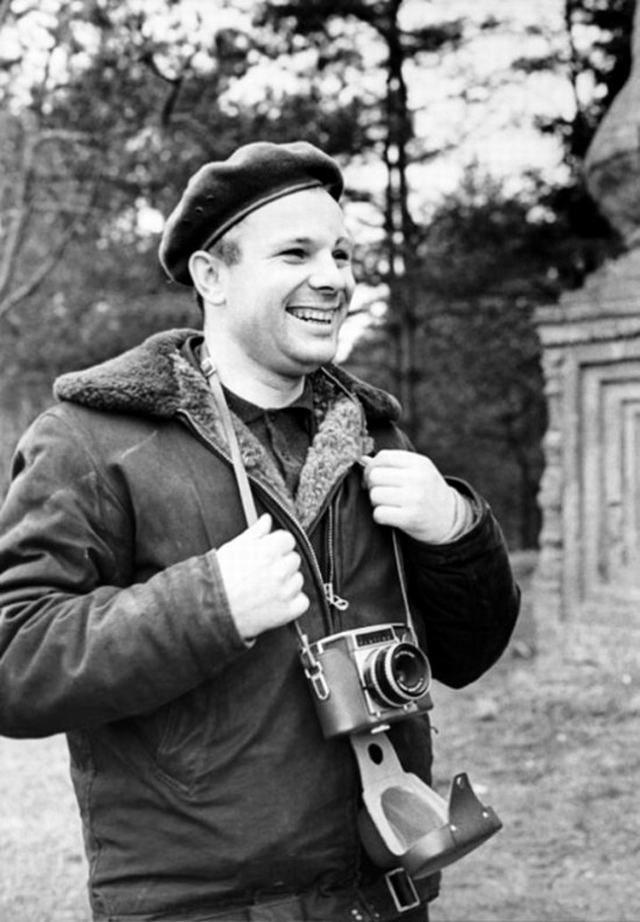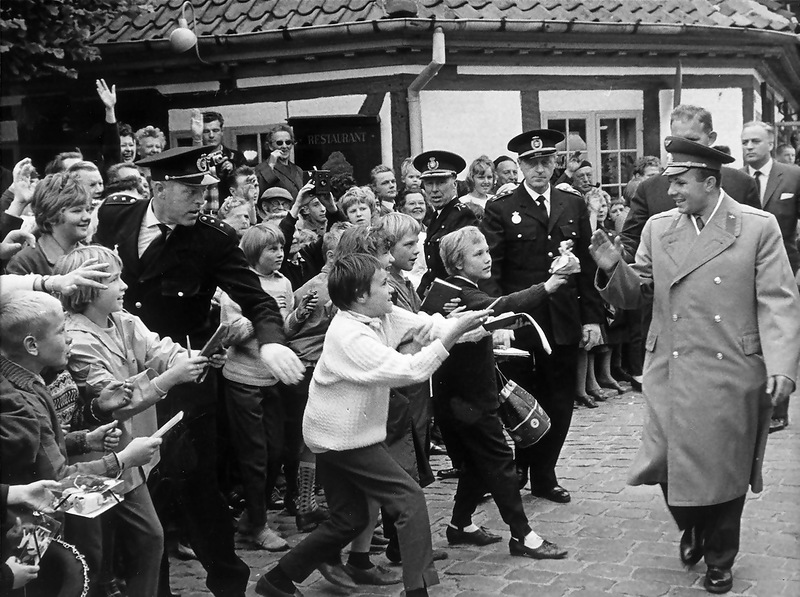 Yuri Gagarin, Hero of the Soviet Union, was a cosmonaut who became the first human to journey into outer space. Traveling in the Vostok 1 capsule, Gagarin completed one orbit of Earth on 12 April 1961. By achieving this major milestone in the Space Race he became an international celebrity.
Yuri Gagarin, Hero of the Soviet Union, was a cosmonaut who became the first human to journey into outer space. Traveling in the Vostok 1 capsule, Gagarin completed one orbit of Earth on 12 April 1961. By achieving this major milestone in the Space Race he became an international celebrity.
The son of a carpenter on a collective farm, Gagarin graduated as a molder from a trade school near Moscow in 1951.
He continued his studies at the industrial college at Saratov and concurrently took a course in flying. On completing this course, he entered the Soviet Air Force cadet school at Orenburg, from which he graduated in 1957.
Gagarin was stationed at the Luostari Air Base, near the Norwegian border, before his selection for the Soviet space programme with five other cosmonauts.
He underwent physical and psychological testing conducted at Central Aviation Scientific-Research Hospital, in Moscow. The commission limited its selection to pilots between 25 and 30 years old.
The chief engineer of the programme Sergei Korolev also specified that candidates, to fit in the limited space in the Vostok capsule, should weigh less than 72 kg (159 lb) and be no taller than 1.70 meters (5 ft 7 in); Gagarin was 1.57 meters (5 ft 2 in) tall.

Gagarin was a candidate favored by his peers; when they were asked to vote anonymously for a candidate besides themselves they would like to be the first to fly, the group chose Gagarin.
One of these candidates, Yevgeny Khrunov, believed that Gagarin was very focused and was demanding of himself and others when necessary. Eventually, the commission formally nominated Gagarin as the primary pilot and Titov as his backup.
 On 12 April 1961, at 6:07 am UTC, the Vostok 1 spacecraft was launched from Baikonur Cosmodrome. Aboard was Gagarin, the first human to travel into space, using the call sign
Kedr
(cedar).
On 12 April 1961, at 6:07 am UTC, the Vostok 1 spacecraft was launched from Baikonur Cosmodrome. Aboard was Gagarin, the first human to travel into space, using the call sign
Kedr
(cedar).
The radio communication between the launch control room and Gagarin included the following dialogue at the moment of rocket launch:
- Korolev: Preliminary stage … intermediate… main… LIFT-OFF! We wish you a good flight. Everything’s all right.
- Gagarin: Off we go! Goodbye, until [we meet] soon, dear friends.
Gagarin’s farewell to Korolev using the informal phrase Poyekhali ! (‘Off we go!’) later became a popular expression in the Eastern Bloc that was used to refer to the beginning of the Space Age.
The five first-stage engines fired until the first separation event, when the four side boosters fell away, leaving the core engine. The core stage then separated while the rocket was in a suborbital trajectory, and the upper stage carried it to orbit.
Once the upper stage finished firing, it separated from the spacecraft, which orbited for 108 minutes before returning to Earth in Kazakhstan. Gagarin became the first human to orbit the Earth.
 “The feeling of weightlessness was somewhat unfamiliar compared with Earth conditions. Here, you feel as if you were hanging in a horizontal position in straps. You feel as if you are suspended”, Gagarin wrote in his post-flight report.
“The feeling of weightlessness was somewhat unfamiliar compared with Earth conditions. Here, you feel as if you were hanging in a horizontal position in straps. You feel as if you are suspended”, Gagarin wrote in his post-flight report.
He also wrote in his autobiography released the same year that he sang the tune “The Motherland Hears, The Motherland Knows” during re-entry.
Gagarin was recognized as a qualified Military Pilot 1st Class and promoted to the rank of major in a special order given during his flight.
 At about 7,000 meters (23,000 ft), Gagarin ejected from the descending capsule as planned and landed using a parachute.
At about 7,000 meters (23,000 ft), Gagarin ejected from the descending capsule as planned and landed using a parachute.
There were concerns Gagarin’s orbital spaceflight records for the duration, altitude, and lifted mass would not be recognized by the Fédération Aéronautique Internationale (FAI), the world governing body for setting standards and keeping records in the field, which at the time required that the pilot land with the craft.
Gagarin and Soviet officials initially refused to admit that he had not landed with his spacecraft, an omission which became apparent after Titov’s flight on Vostok 2 four months later.
Gagarin’s spaceflight records were nonetheless certified and reaffirmed by the FAI, which revised its rules, and acknowledged that the crucial steps of the safe launch, orbit, and return of the pilot had been accomplished. Gagarin is internationally recognized as the first human in space and the first to orbit the Earth.
 Gagarin’s flight was a triumph for the Soviet space programme and he became a national hero of the Soviet Union and Eastern Bloc, as well as a worldwide celebrity.
Gagarin’s flight was a triumph for the Soviet space programme and he became a national hero of the Soviet Union and Eastern Bloc, as well as a worldwide celebrity.
Newspapers around the globe published his biography and details of his flight. He was escorted in a long motorcade of high-ranking officials through the streets of Moscow to the Kremlin where, in a lavish ceremony, Nikita Khrushchev awarded him the title Hero of the Soviet Union.
Other cities in the Soviet Union also held mass demonstrations, the scale of which were second only to the World War II Victory Parades.

Gagarin gained a reputation as an adept public figure and was noted for his charismatic smile. On 15 April 1961, accompanied by officials from the Soviet Academy of Sciences, he answered questions at a press conference in Moscow reportedly attended by 1,000 reporters.
Gagarin visited the United Kingdom three months after the Vostok 1 mission, going to London and Manchester. While in Manchester, despite heavy rain, he refused an umbrella, insisted that the roof of the convertible car he was riding in remain open, and stood so the cheering crowds could see him.
Gagarin toured widely abroad, accepting the invitation from about 30 countries in the years following his flight. In just the first four months, he also went to Brazil, Bulgaria, Canada, Cuba, Czechoslovakia, Finland, Hungary, and Iceland. Because of his popularity, US president John F. Kennedy barred Gagarin from visiting the United States.
Vostok 1 was Gagarin’s only spaceflight, but he served as the backup crew to the Soyuz 1 mission, which ended in a fatal crash, killing his friend and fellow cosmonaut Vladimir Komarov . Fearful that a national hero might be killed, Soviet officials banned Gagarin from further spaceflights.
 After completing training at the Zhukovsky Air Force Engineering Academy in February 1968, he was again allowed to fly regular aircraft.
After completing training at the Zhukovsky Air Force Engineering Academy in February 1968, he was again allowed to fly regular aircraft.
On 27 March 1968, while on a routine training flight from Chkalovsky Air Base, Gagarin and flight instructor Vladimir Seryogin died when their MiG-15UTI crashed near the town of Kirzhach.
The bodies of Gagarin and Seryogin were cremated and their ashes interred in the walls of the Kremlin. Wrapped in secrecy, the cause of the crash that killed Gagarin is uncertain and became the subject of several theories, including several conspiracy theories.
At least three investigations into the crash were conducted separately by the Air Force, official government commissions, and the KGB.
According to a biography of Gagarin by Jamie Doran and Piers Bizony,
Starman: The Truth Behind the Legend of Yuri Gagarin
, the KGB worked “not just alongside the Air Force and the official commission members but against them.”
 The KGB’s report, declassified in March 2003, dismissed various conspiracy theories and instead indicated the actions of airbase personnel contributed to the crash.
The KGB’s report, declassified in March 2003, dismissed various conspiracy theories and instead indicated the actions of airbase personnel contributed to the crash.
The report states that an air-traffic controller provided Gagarin with outdated weather information and that by the time of his flight, conditions had deteriorated significantly.
Ground crew also left external fuel tanks attached to the aircraft. Gagarin’s planned flight activities needed clear weather and no outboard tanks.
The investigation concluded Gagarin’s aircraft entered a spin, either due to a bird strike or because of a sudden move to avoid another aircraft.
Because of the out-of-date weather report, the crew believed their altitude was higher than it was and could not react properly to bring the MiG-15 out of its spin.
 In 1957, while a cadet in flight school, Gagarin met Valentina Goryacheva at the May Day celebrations at the Red Square in Moscow. She was a medical technician who had graduated from Orenburg Medical School.
In 1957, while a cadet in flight school, Gagarin met Valentina Goryacheva at the May Day celebrations at the Red Square in Moscow. She was a medical technician who had graduated from Orenburg Medical School.
They were married on 7 November of the same year, the same day Gagarin graduated from his flight school, and they had two daughters.
Yelena Yurievna Gagarina, born 1959, is an art historian who has worked as the director general of the Moscow Kremlin Museums since 2001; and Galina Yurievna Gagarina, born 1961, is a professor of economics and the department chair at Plekhanov Russian University of Economics in Moscow.
Following his rise to fame, at a Black Sea resort in September 1961, he was reportedly caught by his wife during a liaison with a nurse who had aided him after a boating incident.
He attempted to escape through a window and jumped off a second floor balcony. The resulting injury left a permanent scar above his left eyebrow.
 In his youth, Gagarin was a keen sportsman and played ice hockey as a goalkeeper. He was also a basketball fan and coached the Saratov Industrial Technical School team, as well as being a referee.
In his youth, Gagarin was a keen sportsman and played ice hockey as a goalkeeper. He was also a basketball fan and coached the Saratov Industrial Technical School team, as well as being a referee.
Some sources have said that Gagarin commented during his space flight, “I don’t see any God up here,” though no such words appear in the verbatim record of his conversations with Earth stations during the spaceflight.
In a 2006 interview, Gagarin’s friend Colonel Valentin Petrov stated that Gagarin never said these words and that the quote originated from Khrushchev’s speech at the plenum of the Central Committee of the CPSU about the state’s anti-religion campaign, saying “Gagarin flew into space, but didn’t see any god there”.
Petrov also said Gagarin had been baptized into the Russian Orthodox Church as a child, and a 2011 Foma magazine article quoted the rector of the Orthodox Church in Star City saying, “Gagarin baptized his elder daughter Yelena shortly before his space flight; and his family used to celebrate Christmas and Easter and keep icons in the house”.
















































(Photo credit: Wikimedia Commons / Britannica / Pinterest / Russia Public Archives).


No comments
Post a Comment